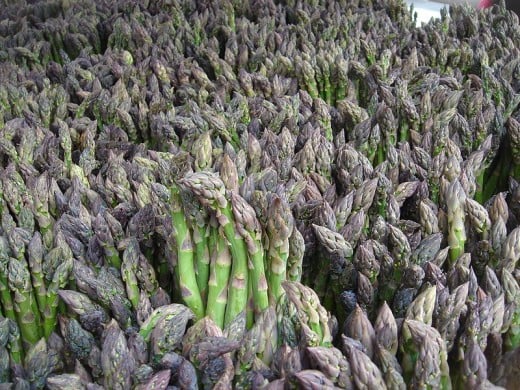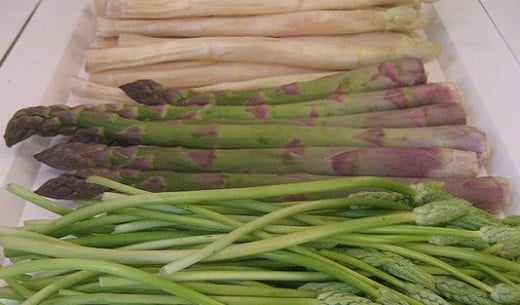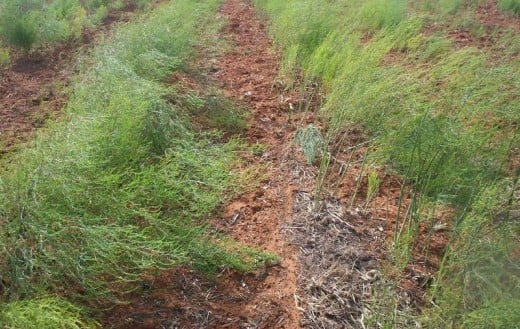What are the Benefits of Asparagus
Where did Asparagus Originate
This is a tough question to answer. It is widely distributed in Europe, northern Africa, and western Asia. It was well known to ancient Egyptians, Greek and Romans.
There is a even a recipe for cooking asparagus in the book De re coquinaria which was written around the third century CE.
Asparagus was used as both vegetable and medicine in ancient times. Because it has diuretic properties it was often "prescribed" for urinary tract problems and as a purifier.
Today Peru is the leading exporter of asparagus followed by China and then Mexico.
The world's leading importers (consumers) are the United States, the European Union, and Japan; in that order.
The word asparagus is derived from the Greek, which got it from the Persian asparag. The Farsi word simply means "sprout."



Asparagus Nutritional Value
Asparagus are surprisingly rich in both fiber and minerals. A three and a half ounce serving will provide 4 grams carbohydrate, 2 grams simple sugar, 2 grams of fiber, 2 grams of protein, plus a complement of "B" vitamins including B1, B2, B3, B5, B6 and B9.
Asparagus also contain vitamin C, calcium, magnesium, iron, phosphorus, potassium zinc.
They also contain manganese, selenium, and copper.
Best of all they are very low calorie.
Health Benefits of Asparagus
With this rich source of minerals and antioxidants asparagus act as diuretic, neutralize ammonia, and protect capillaries (small blood vessels).
It is a natural laxative as well.
The Folate in asparagus is also cited as a good substance for pregnant mothers as it protects against neural tube defects in babies.
Because asparagus acts as a diuretic it is helpful in flushing out toxins and the antioxidants in it have been named as a potential "healthy food" for heart disease.
There are secondary and unsubstantiated claims that it helps with kidney stones. Further claims, again unsubstantiated are that it;
- Lowers bad cholesterol
- Has antifungal and antiviral properties
- Prevents bladder and urinary tract infections
- Great for the intestinal tract especially the colon
There are even more unusual claims that it promotes the production of breast milk, helps get rid of warts, helps with menstrual cramps and even helps with depression.
Choosing Asparagus
Asparagus age rapidly. Look for wilted "heads" or, if buying by the bundle, if the rubber band holding them together dents the flesh.
Asparagus should be eaten within days of purchase if not the same day.
Of course, refrigeration can retard this somewhat, but the best rule of thumb is to eat them shortly after purchase for maximum benefit.
When preparing asparagus for cooking simply snap off the woody part of the shoot. This is easier than trying to gauge where to make a cut as the woody part is much stiffer and has a tendency to separate from the softer part of the shoot when bent.
Growing Asparagus
The plant is interesting in that it is one of the few that actually love salty soils. This means that sewing the soil with a little salt will not only be good for the asparagus, but retard or prevent the growth of weeds.
Despite the salt loving nature of asparagus it's a good companion plant when sewing tomatoes. Tomato plants repel the asparagus beetle and the asparagus plant repels root nematodes known to be harmful to the tomato.
Asparagus crowns are typically (root system) sewn in the winter and the first shoots picked in the spring. Asparagus are very tolerant of soil conditions as long as the root system is not waterlogged. Once established they are also drought tolerant.
Spears should be harvested when they are no more than seven to nine inches long. Any longer and they start to become quite "woody" in order to support the longer length. Stems are simply snapped off without using a knife, since a sharp edge could damage the crown. The stub that remains will soon disappear and new shoots spring up.
Since the spears tend to want to fan out and form a fern like structure you want to harvest them before this starts to happen. At the height of the season harvesting these spears could happen once or twice a day.
Finally, asparagus spears should be picked in the morning. Once picked the spears should be cleaned and dunked in cold water. They can then be refrigerated for two weeks in an airtight plastic bag or container.
Asparagus as Beauty Aid
The water from steamed asparagus can be used as an astringent and blemish fighting rinse for your face.
Note that with all the vitamins and minerals I'm sure there are many other uses for asparagus as natural skin and hair conditioner, but little is written about these benefits.
Less than Usual Asparagus Recipes
First my favorite.
Ingredients
- 1/2 lb bunch of young asparagus sprouts
- 2 Tablespoons olive oil
- 1 clove garlic, minced
Directions
- Heat a fry pan to medium heat.
- Add olive oil and allow to heat to a "shimmer."
- Add asparagus and with tongs, turn the asparagus from one side of the pan to the other allowing all the asparagus sprouts to eventually heat. A rotation of the sprouts from top to bottom of pan is the desired here.
- Just as the asparagus begin to soften add the garlic and continue turning the sprouts.
- When the all sprouts have changed color remove from pan and serve.
By adding the garlic toward the end you avoid burning it and changing it's flavor. Cook the sprouts so they are still slight crisp.
Phyllo Wrapped Asparagus
Phyllo is an unleavened (no yeast or baking powder/soda) dough rolled to a paper thin thickness.
Ingredients
- 8 or 9 Asparagus spears, depending on size
- 1/2 (16-ounce) package frozen phyllo sheets, thawed
- 1/4 Cup butter, melted
- 1/4 Cup finely grated Parmesan
Directions
- Preheat oven to 375° F.
- Snap off the tough ends of the asparagus. (see above Choosing Asparagus)
- Unwrap the phyllo and cut the
stack in half lengthwise.
- Return the other half of the phyllo to the freezer.
- Cover the
phyllo with a damp towel to keep it from drying out.
- Take 1 sheet of
phyllo and brush lightly with some melted butter.
- Sprinkle with some
grated Parmesan cheese.
- Place 2 to 3 asparagus spears on the short end of the sheet.
- Roll up, jelly-roll style.
- Place each piece, seam side down, on a baking
sheet.
- Brush with more melted butter and sprinkle with more Parmesan.
- Repeat until all the asparagus spears are used up.
- Place baking sheet in oven and bake for 15 to 18 minutes, or until golden brown and crispy.
Asparagus Sandwich
Ingredients
- 8 to 10 fresh Asparagus spears, washed and trimmed
- 2 Tablespoons butter, divided
- Salt and pepper or lemon pepper
- 2 slices Pumpernickel bread. Another strongly flavored dense bread works too.
- 2 slices Jack cheese
- 1 or 2 Tablespoons Thousand Island dressing
- 3 slices Red onion, cut into rings
- Pickle slices or fresh parsley, for garnish (optional)
Directions
- Blanch asparagus spears in boiling, salted water for 1 minute.
- Remove immediately to a bowl of ice water.
- Melt 1 Tablespoon butter in a large skillet over medium heat.
- Add
asparagus and lightly saute.
- Season with salt and pepper, or lemon
pepper.
- Remove asparagus from pan and set aside.
- Butter 2 pieces of
bread with the remaining 1 tablespoon butter.
- Place bread in the same
skillet, buttered side down, and grill on 1 side.
- Flip bread and lay 1
piece of cheese on each slice of bread.
- Grill until cheese is melted and
then remove from pan.
- Spread desired amount of dressing on top of each
slice of bread.
- Arrange asparagus on top of cheese, rotating the spears.
- Place onion rings on top of asparagus.
- Cut sandwich in half.
- Garnish with pickle slices or parsley, if desired.











